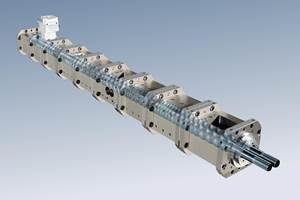Three Friends Team Up For a Second Compounding Venture
When Robert Lapierre, David Valenzky, and Thomas Lacey were in their late 30s and early 40s, the three friends started a custom compounding business to gether.
When Robert Lapierre, David Valenzky, and Thomas Lacey were in their late 30s and early 40s, the three friends started a custom compounding business to gether. They called it Advanced Compounding Services and ran the firm in Cheshire, Conn., for several years until they sold it to another firm. The three entrepreneurs then split up and started companies of their own: Lapierre in sales and plastics consulting, Valenzky in computer controls integration, Lacey in building continuous mixers.
Fifteen years later, after selling out their shares of those businesses to partners, the three got together over beers and reminisced. “When the talk turned to collaborating again, we asked, ‘Do we want to do another company?’” Lapierre recalls. “It was the group of three coming together again.”
In spring of 2002, the trio decided to take the plunge. Lapierre had an idea for a coextruded pellet that could segregate two reactive chemicals in order to make a better blowing-agent masterbatch. This was the basis for the new business. Phaze II opened its doors in Waterbury, Conn., in September.
Lapierre and Valenzky developed the patented additive concentrates. Lapierre also heads up sales and marketing. Lacey designed and built the coextrusion compounding machinery. Valenzky designed the computer systems and controls.
Besides friendship and complementary skills, the group has years of experience with endothermic foaming agents. Advanced Compounding Services made Hydrocerol additives for Boeringer Ingelheim. When BI built its own manufacturing plant in 1997-98, Valenzky’s company designed the computer systems and Lacey’s firm built the continuous mixers. Lapierre worked in consulting, formulation development, and sales for Tramaco, Nortech, B.I. Chemicals, and other makers of endothermic blowing agents.
Phase separation
Phaze II’s name signifies both the group’s second joint enterprise and its key innovation—phase separation of reactive foaming ingredients. Other endothermic foaming agents are pellets containing sodium bicarbonate and citric acid. Phaze II’s separation of the active ingredients allows use of stronger acids that are more effective at lower temperatures. Low melt temperatures increase melt strength and gas solubility for better foaming and lower densities.
“We tested 25 acids for ones that react at lower temperatures than products already on the market,” Lapierre says. Most of Phaze II’s compounds initiate foaming at 300 to 375 F, but the firm has tested acids that work at 280 F. Since competitors’ foaming systems are less reactive at low temperatures, they have higher carbonate content. The resulting higher pH is hard on screws and barrels, Valenzky says.
Separation of acid and carbonate reportedly gives more control of foaming and lower foam density than with competing products. “Typically a chemical foaming agent produces densities as low as 25 pcf, but we get down to 15 pcf with our standard product and 9.5 pcf with special acids,” Lapierre says.
Phase separation is accomplished in two ways. One is a salt-and-pepper blend of single-ingredient (carbonate or acid) pellets. The coextruded pellet is divided down the middle—one side containing the carbonate and the other the acid component.
Phaze II started out offering monolayer Phaze-Cell products in six standard polyolefin and styrenic formulations. Coex pellets will be commercial soon. In a few months, Phaze II plans to offer phase-separated exothermic foaming agents, too.
Losing a partner
Midway through building the coex compounding line that is central to Phaze II’s product development, the team that had looked forward to playing together lost a member. Lacey suffered a heart attack in late January and died a few days later.
Lacey’s son, Tom Jr., has 16 years of plastics-processing experience and had worked with his father on machine designs and start-ups. He quit his job and stepped in to complete building his father’s machine and take over his role in the company. The coex pellet compounding line started production in March.
Related Content
Green’s the Theme in Extrusion/Compounding
The drive toward circular economy is requiring processors to make more use of PCR. Machine builders at K—across all extrusion processes—will be highlighting innovations to help them do just that.
Read MoreImproving Twin-Screw Compounding of Reinforced Polyolefins
Compounders face a number of processing challenges when incorporating a high loading of low-bulk-density mineral filler into polyolefins. Here are some possible solutions.
Read MoreHow to Configure Your Twin-Screw Barrel Layout
In twin-screw compounding, most engineers recognize the benefits of being able to configure screw elements. Here’s what you need to know about sequencing barrel sections.
Read MoreWhat to Know About Your Materials When Choosing a Feeder
Feeder performance is crucial to operating extrusion and compounding lines. And consistent, reliable feeding depends in large part on selecting a feeder compatible with the materials and additives you intend to process. Follow these tips to analyze your feeder requirements.
Read MoreRead Next
Making the Circular Economy a Reality
Driven by brand owner demands and new worldwide legislation, the entire supply chain is working toward the shift to circularity, with some evidence the circular economy has already begun.
Read MorePeople 4.0 – How to Get Buy-In from Your Staff for Industry 4.0 Systems
Implementing a production monitoring system as the foundation of a ‘smart factory’ is about integrating people with new technology as much as it is about integrating machines and computers. Here are tips from a company that has gone through the process.
Read MoreBeyond Prototypes: 8 Ways the Plastics Industry Is Using 3D Printing
Plastics processors are finding applications for 3D printing around the plant and across the supply chain. Here are 8 examples to look for at NPE2024.
Read More

























